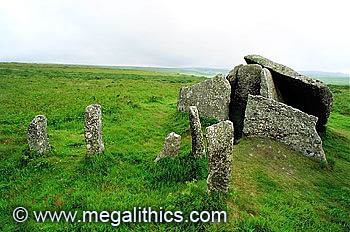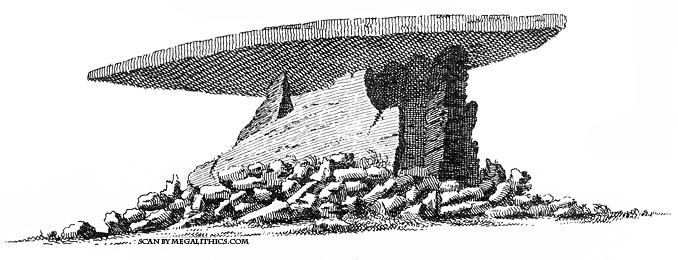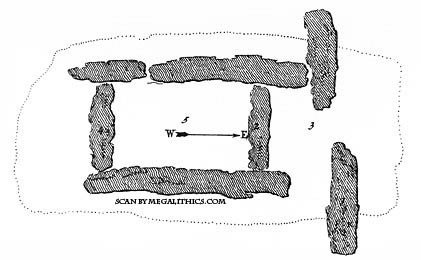
 |
|
Photo Gallery |
|
|
VR Panoramas |
|
| SW 46882 38025 (GPS 70min) | |
| Visited June 2000 | No magnetic anomalies |
The Zennor Quoit stands on moorland about 1km ESE of the village of the same name. The Quoit is perhaps the finest surviving example of the Cornish variant of the portal dolmen. The Cornish form involves the addition of two flanking stones either side of the front closure stone, these flanking stones create a small enclosed space or "forecourt" at the front of the tomb. The more widely known Trethevy Quoit is another example of this modified form.
One of the first accounts of the Senar (Zennor), Quoit was in 1769 by W.Borlase (1), in which he published the two diagrams of the tomb below.

There are two striking differences between
the above engraving and the tomb as it stands today. The first is the large amount of
cairn material remaining around the Quoit, as Borlase (1) writes " the
Stone Barrow fourteen yards in diameter was heaped round about it".
Although there is a slightly raised area around the Quoit today, the mound of
cairn stones seen by Borlase has long since been robbed away. The second
difference is the attitude of the capstone which is seen to be almost level in
Borlase's engraving and he mentions that the internal height " which is
about eight feet, at medium under the plane of the Quoit, is remarkable".
The capstone today is pitched at a very steep angle and rests so closely on the
sloping side slabs that entry to the chamber is very difficult. The probable
cause of the change in the position of the capstone is mentioned in a local
newspaper (2) in 1861 :
"A farmer had removed part of one of the upright
pillars, and drilled a hole into the slanting quoit in order to erect a
cattle-shed, when news of the vandalism reached the ears of Rev. W. Borlase,
vicar of Zennor, and for five shillings the work of destruction was stayed, the
vicar thus having strengthened the legend that the quoit cannot be
removed."
If the above engraving is accurate, it is most probable that the upright that
was truncated by the farmer was the chamber back stone, this would have caused
the roof stone to slide backwards until it rested on the side slabs and the
ground at the rear, and this is exactly the present situation of the Quoit.

A Borlase came to the defence of the Zennor Quoit again in 1882 during a visit to the Quoit by the Penzance Natural History and Antiquarian Society, the following account is from Matthew's History (3). "Mr. Borlase, one of the members, met with a man who had made a find beneath the Zennor Quoit. The man explained that about a year ago , finding that other people were searching about, he and his son thought they would have 'a bit of a speer too.' After removing some of the earth, they came upon a flat stone, which they 'shut' (blasted). They then removed more earth and came upon another flat stone, which they also 'shut.'. Underneath it they found what Mr. Borlase said was an ancient whetstone, which no doubt was buried with the dead, in order that he might have something to sharpen his weapons with in 'the happy hunting grounds' to which he was supposed to have gone. Mr. Borlase had found similar stones, with urns containing the ashes of the dead, in different barrows. Under this quoit he found part of an urn. Mr.Borlase expressed a hope that there would be no more 'shutting' near the quoit, because it ought to be regarded as sacred as the grave of a father".
Probably the best early description of the Quoit is by W.C. Borlase (4), although he draws heavily on the account by his grandfather (1), describing the Quoit is those days as "the most interesting and perfect specimen of a Kist-Vaen in Western Cornwall". He reproduces copies of the engravings shown here, writing that they "will be found much more accurate and valuable than any sketch of the ruin, as it is at present, could possibly be", this is because the monument had been "much impaired" by "progress and destruction, working together as usual". Borlase was referring to the destruction halted by his grandfather as described above, although his version of the damage tells how the stones were to be used as "the supports of a cart-shed".
More modern accounts of the
monument by Hencken (5) and Daniel
(6) are brief, although Daniel does give
details of finds. The whetstone found by the 'shutters' above (whom Daniels
informs us were named Grenfell), is stated as being in the Penzance Museum, and
that some 'urns' had been found in the eastern part of the tomb, thankfully
prior to the explosive excavations of the Grenfells. Fragments
of cord-decorated pottery "thrown up by rabbits just outside the
entrance" were discovered by, and were in the private collection of,
a Mr. S. Hazzeldine Warren of Loughton.
Both of the later authors publish plan
diagrams of the Quoit, these show marked differences to each other, particularly
in the position of the northern side stones and the roof stone itself. We
thought that the plan by Hencken was closest to the layout we saw and
photographed during our visit.
The capstone at Zennor is massive, weighing an estimated 12.5 tons, as mentioned above it has been repositioned and is now a very close fit on the rear slopes of the lateral slabs. In fact, all of the surviving chamber slabs fit together so well, that we could not squeeze into the burial chamber. A short distance from the facade of the Quoit stand five upright stones in a 90 degree arrangement, we have not been able to discover any mention of this structure in modern or antiquarian literature.
W. Borlase (1) writes that "This Quiot was brought from a Karn about a furlong off" and that "near this Karn is another Cromleh", he is referring to the Sperris Quoit 300m to the SE, which has since been reduced to a sad ruin.
1. Borlase W.
Antiquities Historical and Monumental of the County of Cornwall, Bowyer and
Nichols, London 1769
2. Cornish Telegraph, 4th Sept. 1861
3. Matthews J.H., A Guide to St.Ives and its Surroundings (Part3), 1884 James
Wearne, St.Ives.
4. Borlase W.C., Naenia Cornubiae, 1872 Longmans.
5. Hencken H., The Archaeology of Cornwall and Scilly, 1932 Metheun.
6. Daniel G.E., The Prehistoric Chamber Tombs of England and Wales, 1950
Cambridge University Press.